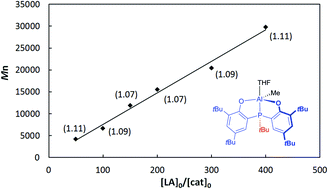Aluminum complexes containing biphenolate phosphine ligands: synthesis and living ring-opening polymerization catalysis†
Abstract
This report describes the synthesis, structure, and reactivity of aluminum complexes containing tridentate biphenolate phosphine ligands of the type [RP(2-O-3,5-C6H2tBu2)2]2− (R = tBu (2a), Ph (2b)). Alkane elimination of AlMe3 with one equiv. of H2[2a] or H2[2b] in THF at 0 °C cleanly affords colorless crystalline [2a]AlMe(THF) (3a) and [2b]AlMe(THF) (3b), respectively. An X-ray diffraction study of 3a showed it to be a five-coordinate THF-bound species, whose coordination geometry is best described as trigonal bipyramidal, having the phosphorus donor and THF at axial positions. Treatment of either in situ prepared or isolated methyl complexes 3a,b with one equiv. of benzyl alcohol in toluene or THF generated their corresponding benzyloxides {[2a,b]Al(μ2-OCH2Ph)}2 (4a,b). An X-ray diffraction study of 4a revealed a dimeric structure, in which the coordination geometry of aluminum is also distorted trigonal bipyramidal with the tridentate 2a ligand being facially bound. In the presence of one equiv. of benzyl alcohol, complex 3a is a competent catalyst precursor for the living ring-opening polymerization of ε-caprolactone (ε-CL) and rac-lactide (rac-LA), producing poly(ε-caprolactone) and poly(rac-lactide), respectively, in a controlled manner. As such, well-defined block copolymers of ε-CL with rac-LA can also be prepared by catalytic 3a. Kinetic studies revealed that 3a catalyzes the polymerization of rac-lactide at a rate 2-fold faster than that of 3b, indicating the significance of the P-substituent effect on this catalysis. Interestingly, the polymerization rate of rac-lactide by 3a is 16.5 times faster than that of L-lactide under otherwise identical conditions.

- This article is part of the themed collection: Reactions Facilitated by Ligand Design

 Please wait while we load your content...
Please wait while we load your content...